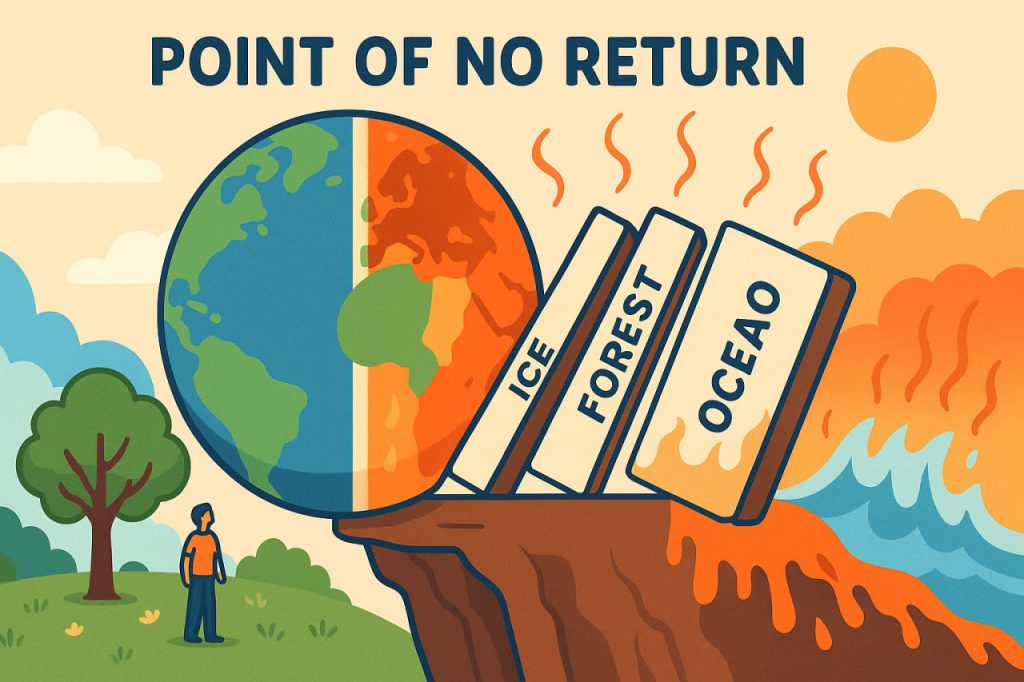The term “point of no return” in climate science refers to a critical threshold beyond which environmental changes become self-sustaining and irreversible. Once crossed, these processes continue to accelerate, even if humanity completely stops emitting greenhouse gases. Understanding these tipping points is vital for protecting the stability of Earth’s ecosystems and ensuring a livable future.
What Is a Climate Tipping Point?
A climate tipping point is a specific boundary in the Earth’s climate system where a small disturbance can trigger a large, often irreversible change. It’s like pushing a ball over a hill — once it rolls down the other side, it cannot return without tremendous energy. These tipping points are connected to feedback mechanisms that amplify warming or cooling trends.
Examples include the melting of polar ice, collapse of major ecosystems, and disruption of ocean circulation. Once triggered, such events can permanently alter the global climate and reshape life on the planet.
Major Climate Tipping Points on Earth
Scientists have identified several critical tipping points that are already showing signs of instability:
- Arctic Sea Ice Loss
- Sea ice reflects sunlight back into space. When it melts, darker ocean water absorbs more heat, accelerating global warming.
- This albedo effect amplifies the rate of temperature increase in polar regions.
- Greenland and Antarctic Ice Sheets
- Melting of these ice sheets could raise sea levels by up to 13 meters over centuries.
- Once the melting surpasses a certain limit, gravity and heat flow ensure the process continues uncontrollably.
- Permafrost Thawing
- Frozen soils in Siberia, Alaska, and Canada contain massive amounts of methane and carbon dioxide.
- As they thaw, these gases are released, amplifying greenhouse effects in a feedback loop.
- Amazon Rainforest Dieback
- Deforestation and drought could turn the Amazon from a carbon sink into a carbon source, releasing billions of tons of CO₂.
- This transformation would disrupt rainfall patterns across South America and beyond.
- Atlantic Ocean Circulation (AMOC)
- The ocean conveyor belt that redistributes heat across the planet may weaken due to melting ice and freshwater inflow.
- A collapse could cause drastic cooling in Europe and intensified tropical storms elsewhere.
- Coral Reef Collapse
- Rising ocean temperatures and acidification cause coral bleaching, threatening marine biodiversity and food chains.
Why the “Point of No Return” Matters
Crossing these tipping points means entering a new climatic state where restoring previous conditions becomes impossible on human timescales. Even if greenhouse gas emissions were reduced to zero, processes like ice loss or methane release would continue for centuries.
This creates a domino effect — one tipping point can trigger others, leading to cascading climate shifts. For example, melting permafrost releases methane, which accelerates warming, leading to faster ice melt and ocean changes.
How Close Are We?
Current scientific data suggest that several tipping points are dangerously near or already partially activated:
- The Arctic could experience ice-free summers as early as the 2030s.
- Permafrost is thawing faster than models predicted.
- The AMOC is slowing and could weaken by up to 40% by 2100.
The Earth’s average temperature has already risen by 1.2°C since pre-industrial times. Many experts warn that exceeding 1.5°C may trigger multiple tipping points simultaneously.
Preventing Irreversible Change
Avoiding the point of no return requires immediate global cooperation. Key actions include:
- Rapidly transitioning to renewable energy (solar, wind, hydro).
- Protecting and restoring forests and wetlands.
- Reducing methane and carbon emissions.
- Supporting sustainable agriculture and circular economies.
- Developing carbon capture and storage technologies.
Individual efforts, like reducing waste, conserving energy, and promoting awareness, also contribute to the larger solution.
The Role of Science and Society
Monitoring potential tipping points is one of modern science’s most urgent missions. Satellite data, ocean buoys, and climate models help detect early warning signs. However, solutions require political will and global responsibility — delaying action risks crossing boundaries that no technology can reverse.
P.S. Only a united humanity can cope with the global challenges of today’s civilization. The more people in the world see the global situation on the planet and take action, the more likely it is that our children will see a better future.
Interesting Facts
- A tipping point in the Greenland ice sheet could be triggered at just 1.5°C of warming.
- The Amazon rainforest produces 20% of Earth’s oxygen and stores 90–140 billion tons of carbon.
- Permafrost regions store nearly twice as much carbon as the entire atmosphere.
- A shutdown of the Atlantic circulation would make Northern Europe much colder, despite global warming.
- Scientists compare climate tipping points to “falling dominos” — one event can set off several others.
Glossary
- Tipping point — a critical threshold beyond which a system changes drastically and irreversibly.
- Feedback loop — a process that amplifies or reduces changes within a system.
- Albedo effect — the reflection of sunlight by Earth’s surface; ice has high albedo, while dark water has low.
- Permafrost — permanently frozen ground containing carbon-rich material.
- AMOC (Atlantic Meridional Overturning Circulation) — a system of ocean currents that regulates global climate.


